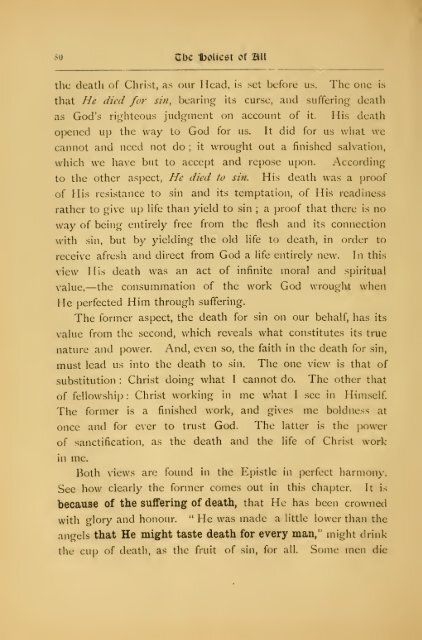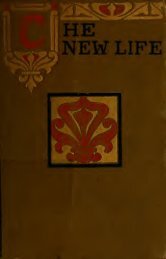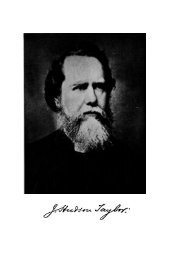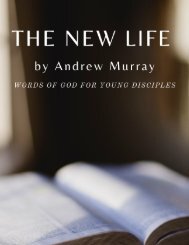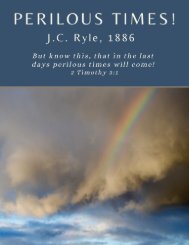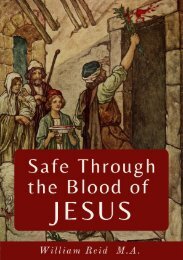- Page 1 and 2:
P5J^^W^>^:'
- Page 3 and 4:
THE HOLIEST OF ALL
- Page 5 and 6:
THE HOLIEST OF ALL ^N EXPOSITION OF
- Page 7 and 8:
PREFACE. When first I undertook the
- Page 9 and 10:
Ipcefacc vii the very presence of G
- Page 11 and 12:
CONTENTS. THE EPISTLE INTRODUCTION
- Page 13 and 14:
Contents FOURTH SECTION.-iv. 14-v.
- Page 15 and 16:
Contents SECOND HALF-PRACTICAL. Cha
- Page 17:
Contents TWELFTH SECTION.-ziil. 1-2
- Page 20 and 21:
; : The Son—the Everlasting: Crea
- Page 22 and 23:
Zbc Ibolfest of ail ' Ch. 3. 12. *C
- Page 24 and 25:
Zbc -fcoliest of BU THE THIRD WARNI
- Page 26 and 27:
. 20 . n, Zbe Dolicst of BU 'Ch 10.
- Page 28 and 29:
•' 10 ;rbe IboUcdt of mi Christ,
- Page 30 and 31:
12 Jibe tboliest ot mi SECOND HALF-
- Page 32 and 33:
14 Zbe -boUcst ot Bll them and gree
- Page 34 and 35:
um 16 ^be tjouest of Bll The Fifth
- Page 37 and 38:
INTRODUCTION. Ere we enter upon the
- Page 39 and 40:
Zbe Iboliest of ail 21 2. To WHOM T
- Page 41 and 42:
Zbc Iboliest ot au He sets himself
- Page 43 and 44:
^be Ibolicst of 2111 25 In this sum
- Page 45:
XLbe Iboliest ot Bll 27 the glory o
- Page 49 and 50: THE THEME -i. 1-3. The Glory of the
- Page 51 and 52: ^be Iboliest of Bll 33 they ought t
- Page 53 and 54: Zbc IboUeet of Bll 35 II. THE SON-M
- Page 55 and 56: Zbc iboiteet of ail 37 and the stro
- Page 57 and 58: Zbe Iboliest of Bll 39 III. THE SON
- Page 59 and 60: XLbe -ffjoitcst of :aii 41 for our
- Page 61 and 62: ^be IbolieBt of mi 43 IV. THE SON-T
- Page 63 and 64: Zbe Ibollest of ail 45 applied in t
- Page 65 and 66: G:I)C HMXCSt Ot BU 47 FIRST SECTION
- Page 67 and 68: Ubc iboUest ot Bii 49 Saviour, but
- Page 69 and 70: ^be iFjoUcst of ail 51 VL THE SON-T
- Page 71 and 72: Zbc Ibolicst of ail 53 Himself, in
- Page 73 and 74: Zbc ifjoUcst of ail VII. THE SON HI
- Page 75 and 76: the throne of God. Zbe "Iboliest of
- Page 77 and 78: ^Tbe IboKcst of ail 59 VIII. THE SO
- Page 79 and 80: XLbe -ffjolicst of mi 6i Word. The
- Page 81 and 82: ZbC 1l30UC5t Of mi 63 IX. THE SON-O
- Page 83 and 84: XLbc Iboliest of ail 65 the love of
- Page 85 and 86: TLbe Iboliest of au 67 THE FIRST WA
- Page 87 and 88: ^be I[30lie3t of ail 69 away " unco
- Page 89 and 90: Cbe -ffjoliest of ail 7i SECOND SEC
- Page 91 and 92: trbe 1f3oIiest ot Bll 73 was becaus
- Page 93 and 94: Zbc -ffjoUest of HU XII. WE SEE JES
- Page 95 and 96: ' trbc Iboliest of ail 77 way of li
- Page 97: JLbc Ibolicet of ail 79 XIII. JESUS
- Page 101 and 102: Zbc 1F30[(est of 2111 ss XIV. THE L
- Page 103 and 104: Zbe Ibollest of mi 85 inclination w
- Page 105 and 106: ^be 1F30licst of au 87 XV. FOR WHOM
- Page 108 and 109: 90 z\K iboUcst Of ail for God, and
- Page 110 and 111: 92 vTbe Iboltcst or ail out of One.
- Page 112 and 113: .' What a blessed life I what a ful
- Page 114 and 115: Zbc IboUcst of au all that it means
- Page 116 and 117: 98 XLbc tbolicst of ail the double
- Page 118 and 119: 100 zbe -fcollest of ail him witli
- Page 120 and 121: 102 ^bc ibolieet of BU and compassi
- Page 122 and 123: 104 zbe Iboltcst of Bll human natur
- Page 124 and 125: 106 zbc Ibolicst ot ail Listen, God
- Page 126 and 127: having died for us, helps us in our
- Page 128 and 129: no Zbe 'boliedt of BU goes out to J
- Page 130 and 131: 112 Zbc l5olici5t of ail The words
- Page 132 and 133: 114 Zbc t>oliest of ail the assuran
- Page 134 and 135: 116 ZbC t>Oll€dt Ot Bll they hear
- Page 136 and 137: 118 ' Jibe Dollest of ail heart. Ou
- Page 138 and 139: 120 Cbe Iboliest ot ail the Holy Gh
- Page 140 and 141: 122 Zbc Ibolicst of all truths of t
- Page 142 and 143: 124 zbe Doltcet of ail salvation He
- Page 144 and 145: 126 (XbC IboUcdt of BU hope, To-day
- Page 146 and 147: 128 XLbc -toolicet ot ail let us, i
- Page 148 and 149:
130 Cbc IboUcst of Sll upon single,
- Page 150 and 151:
1S2 tLbe Iboltedt ot Bll maintainin
- Page 152 and 153:
134 trbC tOllCSt Of a[[ whom all th
- Page 154 and 155:
136 Zbc KxMicst of ail the outset,
- Page 156 and 157:
138 Zbe ttoUeet of ail intercourse.
- Page 158 and 159:
140 Zb€ IboUedt of »U God comman
- Page 160 and 161:
142 {Ebe t>oUedt of BIl salvation o
- Page 162 and 163:
144 zbe ftoUegt of ail us not to re
- Page 164 and 165:
146 ^be Iboliest of Hll and Joshua.
- Page 166 and 167:
148 irbc -fcoucflt or Bii One, and
- Page 168 and 169:
ir.o ube Ibollest of ail will was H
- Page 170 and 171:
152 ttbe fjoUegt of HU to His work.
- Page 172 and 173:
154 zbe IboUest of ail enter. Excha
- Page 174 and 175:
166 trbe IboUcet of BU enter in. It
- Page 176 and 177:
158 Zbc IboUcet of Bll Rest, and Je
- Page 178 and 179:
ICO xibe t>oUedt of Bll followiiii^
- Page 180 and 181:
162 Zhe Iboliest of au sin and wret
- Page 182 and 183:
164 Cbe 1bolic5t of Bll been set fo
- Page 184 and 185:
166 ^be -fcolicst of mi through the
- Page 186 and 187:
108 zbc iboliciJt of ail For we hav
- Page 188 and 189:
170 ^be IboUest of BU blessed High
- Page 190 and 191:
172 ZbC tOUC6t Of ail nigh, but by
- Page 192 and 193:
174 Zbc Ibollest of au \vc produce
- Page 194 and 195:
176 Zbc Ibolicgt of Hll at once be
- Page 196 and 197:
178 (Tbc -fcoliest of BH elevated t
- Page 198 and 199:
180 Zbe Ibolicst of ail No man take
- Page 200 and 201:
182 tTbe iJoHest of ail Do thou wha
- Page 202 and 203:
184 XLbe fboUeet of ail Who in the
- Page 204 and 205:
ISO Ube t>oUc0t ot Bll the flesh is
- Page 206 and 207:
188 zbe fjolicst of mi in Himself p
- Page 208 and 209:
190 zrbe fyoUeet of Bll priesthood
- Page 210 and 211:
192 ^be fboliest of mi in humility
- Page 212 and 213:
194 TTbc Ibollcet of Sll Christ was
- Page 214 and 215:
190 Cbc Iboliedt ot Bll siders more
- Page 216:
198 Zbc Ibollcst of Hll thought is
- Page 219 and 220:
Zbc Ibolicst of Bll 201 l/iere zvas
- Page 221 and 222:
Zbc fbolicet of Bll 203 XLIV. LET U
- Page 223 and 224:
XLbe "Iboliest of mi 205 and press
- Page 225 and 226:
Zbc IboUest of au 207 XLV. THE DANG
- Page 227 and 228:
iLbe IboUest of Bll 209 changed, wh
- Page 229 and 230:
JTbe Ibollest of Bll 211 XLVI. OF D
- Page 231 and 232:
elements of a healthy Christian lif
- Page 233 and 234:
Zbe Dolicst of mi 215 XLVII. INHERI
- Page 235 and 236:
Zbc Ibollest of ail 217 God blessed
- Page 237 and 238:
JZbe Ibolicst of ail 219 XLVIII. TH
- Page 239 and 240:
we ZbC IbOltCSt Ot mi 221 strong en
- Page 241 and 242:
Cbe iboliest of BU 223 XLIX. THE FO
- Page 243 and 244:
Zbc Iboliest of BU 225 acceptance o
- Page 245 and 246:
Zlic IboUest of an 227 FIFTH SECTIO
- Page 247 and 248:
trbe Ibolfcst of ail 229 His Son. R
- Page 249 and 250:
tlbe Iboliest of BU 28i LI. MELCHIZ
- Page 251 and 252:
Zbe Iboliest of ail These are indee
- Page 253 and 254:
Zbc fbolicet of mi 235 LI I. MELCHI
- Page 255 and 256:
^be Iboliest of BU 237 should arise
- Page 257 and 258:
{Tbc ibolicst of ail LIII. A PRIEST
- Page 259 and 260:
^bc IboUeet of BU 241 The one is th
- Page 261 and 262:
Zbc ibolfest of Bli 248 LIV. A BETT
- Page 263 and 264:
tTbe IboHest ot mi 245 and holy One
- Page 265 and 266:
^be 1boHc6t of Bll 247 LV. JESUS, T
- Page 267 and 268:
XLlic IboUest of m\ 249 life, in wh
- Page 269 and 270:
Zbe Ibolfcst of Bll 251 LVI. A PRIE
- Page 271 and 272:
trbc Iboliest of mi 253 because He
- Page 273 and 274:
ZbC IbOliCSt of ail 265 LVII. SUCH
- Page 275 and 276:
Ilbe Iboliest of ail 257 into the t
- Page 277 and 278:
ttbe Iboliest of ail 259 SIXTH SECT
- Page 279 and 280:
Zbc IboUcst of Bll 261 possession a
- Page 281 and 282:
Zbc Iboliest of au 263 LIX. THE PRI
- Page 283 and 284:
' ZbC IbOKCSt of ail 265 A priest m
- Page 285 and 286:
Zbe tbollest of ail 267 LX. THE PRI
- Page 287 and 288:
Zbe Ibolicst of BU 269 have direct
- Page 289 and 290:
Cbe Iboliest of BU 271 LXI. THE CEN
- Page 291 and 292:
Zbc fboUeet of Bll 273 into an oak
- Page 293 and 294:
trbe Iboliest of mi 275 LXII. THE C
- Page 295 and 296:
^be Iboliest of BlI 277 way by whic
- Page 297 and 298:
Zbc Iboliest of au 279 LXIII. THE I
- Page 299 and 300:
' ZTbe Iboliest of mi 281 farther b
- Page 301 and 302:
Ube IboUcst of ail 283 SEVENTH SECT
- Page 303 and 304:
^be Iboliest of Bll 28£ even he on
- Page 305 and 306:
Zbc Ibollest of Bll 287 LXV. THE HO
- Page 307 and 308:
trbe -holieet of Bll 289 pensations
- Page 309 and 310:
Zbe Iboliest of BU 291 LXVI. THE OP
- Page 311 and 312:
Zbc Iboliest ot Bll 29s the two abo
- Page 313 and 314:
^be Iboliest of mi 295 LXVII. THE P
- Page 315 and 316:
lood ; of the obedience unto death,
- Page 317 and 318:
XTbe Iboliest of au 299 LXVIII. THE
- Page 319 and 320:
Zbc IboHest of ail 3oi such mighty
- Page 321 and 322:
Zbc Iboliest of ail sos LXIX. THROU
- Page 323 and 324:
Zbe IboUest of Bll 305 Christ humbl
- Page 325 and 326:
^be ibolteet of Bll 307 LXX. THE PO
- Page 327 and 328:
^be Ibolieat of mi 309 admit within
- Page 329 and 330:
Zbc iboliegt of Bll sii LXXI. THE P
- Page 331 and 332:
ZJoe Ibolicst of %n 3i3 with sin pu
- Page 333 and 334:
TLbc Iboliest of mi sis LXXII. EVEN
- Page 335 and 336:
^be ibollest ot Bil 317 atonement,
- Page 337 and 338:
^be Doliest of Bit 319 LXXIII. HEAV
- Page 339 and 340:
Zhc IboUcst of Hll 321 Heaven itsel
- Page 341 and 342:
Zbc iboliest of Hll 323 LXXIV. SIN
- Page 343 and 344:
^be Ibolicat of »ll 325 promise to
- Page 345 and 346:
Zbc Ibolieet of mi 327 SECTION EIGH
- Page 347 and 348:
Zbc Iboltest of mi 329 what the goo
- Page 349 and 350:
Zbe Iboliest of ail 331 LXXVI. A BO
- Page 351 and 352:
Zbe Iboliest of au 333 this the bur
- Page 353 and 354:
Jibe Iboltest of HU 335 lIxxvii. LO
- Page 355 and 356:
XLbc ibollest of Bll 337 will of Go
- Page 357 and 358:
Cbe IboUest ot 2111 LXXVIII. ONCE A
- Page 359 and 360:
Zhc lF)olleBt of ail 341 was so fin
- Page 361 and 362:
^be Iboliest ot Bll 343 LXXIX. THE
- Page 363 and 364:
Zbe Ibolieet of mi 345 God should b
- Page 365 and 366:
Ube 1bolle6t of mi 347 said, LXXX.
- Page 367 and 368:
ITbe Ibollest of ail 349 offering f
- Page 369 and 370:
SECOND HALF-PRACTICAL. -Ch. x. 19-x
- Page 371 and 372:
^bc 1bolie6t of Bll 353 LXXXI. THE
- Page 373 and 374:
Zbe Iboliest ot 2111 355 opened the
- Page 375 and 376:
trbe Ibollest ot HU 357 LXXXII. BOL
- Page 377 and 378:
Zbe iboliest of mi 359 The blood of
- Page 379 and 380:
^be iboUeet of mi 36i LXXXIII. THE
- Page 381 and 382:
XLbe Ibollest of BU 363 t/iaf the l
- Page 383 and 384:
^be Iboltcst of Hll 365 near. LXXXI
- Page 385 and 386:
trbc IboUest ot BU 367 Adam was our
- Page 387 and 388:
ITbe Ibolicst of mi 369 LXXXV. WITH
- Page 389 and 390:
^be Iboliest of Bll 371 of the whol
- Page 391 and 392:
Zbc fboucet ot Bll 373 LXXXVI. THE
- Page 393 and 394:
XTbe Iboliest of Bll 375 persuasion
- Page 395 and 396:
trbe Iboliest of ail 377 LXXXVII. O
- Page 397 and 398:
Ubc Iboliest of Bll 379 upper world
- Page 399 and 400:
trbe Ibollest ot BU 38i LXXXVIII. O
- Page 401 and 402:
^be IboUcst of mi 383 reason was th
- Page 403 and 404:
XLbc IboHeat of ail 385 LXXXIX. LET
- Page 405 and 406:
^be Iboliest of Bll 387 have hopele
- Page 407 and 408:
Zbc Ifooliest of BU 389 XC. THE CON
- Page 409 and 410:
trbe IboUest of BU 391 For He is fa
- Page 411 and 412:
Zbe 1boliC6t of Bll 393 XCI. LOVE A
- Page 413 and 414:
XLU IbOliCSt Ot Bll 395 that can pr
- Page 415 and 416:
Zbc IboUcst of mi 397 XCII. THE ASS
- Page 417 and 418:
Cbe Iboliest of BU 899 too humble o
- Page 419 and 420:
Zbe IboUest of ail 401 THE FOURTH W
- Page 421 and 422:
Zbe Iboliest of au 403 and a walk i
- Page 423 and 424:
^bc fboliest of Bll 405 XCIV. THE S
- Page 425 and 426:
XLbc Iboliest of mi 407 And the Son
- Page 427 and 428:
Cbe •(F30llest of ail 409 XCV. TH
- Page 429 and 430:
Cast XLbc Ibolicst of Bll 411 influ
- Page 431 and 432:
ZbC "DOUCSt Ot ail 413 XCVI. BOLDNE
- Page 433 and 434:
Zbc IboUest ot ail 4i5 the faith th
- Page 435 and 436:
?Cbe iboUest of B» 417 XCVII. BELI
- Page 437 and 438:
TLbc IboUest ot ail 419 That means
- Page 439 and 440:
tlbe IboUeet of mi 421 TENTH SECTIO
- Page 441 and 442:
Cbe 1bo«c0t of ail 422 the word mu
- Page 443 and 444:
Zbc IboUcst of mi 42J XCIX. ABEL-TH
- Page 445 and 446:
;rbe Iboliest of ail 427 the sacrif
- Page 447 and 448:
^be ibollest ot Hll 429 ENOCH-THE W
- Page 449 and 450:
^be Iboliest ot ail 431 presence, b
- Page 451 and 452:
Zbe Iboliest of ail 433 CI. NOAH-TH
- Page 453 and 454:
Zbc Iboliest ot au 435 likeness in
- Page 455 and 456:
ZbC IbOUCSt of ail 437 CI I. ABRAHA
- Page 457 and 458:
^bc ibollest of HU 439 principles o
- Page 459 and 460:
^be Iboliest of Bll 44i CI II. SARA
- Page 461 and 462:
^be IboUest of Bll 443 that promise
- Page 463 and 464:
Zbc Ibolfest of mi U5 CIV. FAITH-AN
- Page 465 and 466:
Zbc Iboliest of ail ui much of His
- Page 467 and 468:
?rbc Iboliest of BH 449 CV. FAITH C
- Page 469 and 470:
Zbe Iboliest of mi 451 power of fal
- Page 471 and 472:
^be fboUcst of ail 453 CVI. FAITH B
- Page 473 and 474:
^'.K IbOKCgt of nil 455 and what He
- Page 475 and 476:
Zbc Iboliest of au 457 CVII. MOSES,
- Page 477 and 478:
Zbc Iboliest of ail 459 this is wha
- Page 479 and 480:
Zbc Iboliest of ail 46i CVIII. ISRA
- Page 481 and 482:
Zbc Iboliest ot Bii 463 Egypt, God
- Page 483 and 484:
Zbc IboUest of Bll 465 CIX. FAITH,
- Page 485 and 486:
ZbC IFjOUeSt of ail 467 that God ca
- Page 487 and 488:
they ZbC IboUCSt of ail 469 ex. FAI
- Page 489 and 490:
JTbe iboilest of Hii m God, maintai
- Page 491 and 492:
ttbC IbOllCSt Ot Hll 473 CXI. SOME
- Page 493 and 494:
XLbc IboUeet of Bll 475 That apart
- Page 495 and 496:
^be tbolicet of mi 477 ELEVENTH SEC
- Page 497 and 498:
Zbc Iboliest of Bli 479 and the hon
- Page 499 and 500:
JTbc IFJoliest of Bll 481 CXI 1 1.
- Page 501 and 502:
Zbe fbolicst of Bll 483 to Jesus in
- Page 503 and 504:
Zbe IboKest of BU 485 CXIV. FAINT N
- Page 505 and 506:
Zbc ibolicst of ail 487 chastening
- Page 507 and 508:
God Zbc Iboliest of BU 489 CXV. CHA
- Page 509 and 510:
XLbC IfoOliCSt of ail 491 ought to
- Page 511 and 512:
iLbc ffjoliest of mi los CXVI. YET
- Page 513 and 514:
^be IboUest of Bll 495 gird yoursel
- Page 515 and 516:
Zbc iboliest of BU 497 THE FIFTH WA
- Page 517 and 518:
^be IboHest of Bll 499 in the will
- Page 519 and 520:
Zbc fbolicst of ml 501 CXVIII. OF F
- Page 521 and 522:
Cbc Ibolicst of ail 503 satisfactio
- Page 523 and 524:
c:be -ffjoUeet of ail 505 CXIX NOT
- Page 525 and 526:
^bc:ibolicst of Bll 507 to do it. I
- Page 527 and 528:
Zbc iboUest ot ail 509 CXX. YE ARE
- Page 529 and 530:
^be ibollcst of ail sii us live as
- Page 531 and 532:
Cbe 1F30l(eet of Bll sis CXXI. OUR
- Page 533 and 534:
Zbc iboUest of BU 5i5 not only acce
- Page 535 and 536:
«Ibe iboliest of ail 517 TWELFTH S
- Page 537 and 538:
Zbc Iboliest of Hll 5i9 in deeds. O
- Page 539 and 540:
trbe iboliest of ail 521 CXXIII. FA
- Page 541 and 542:
^be Ibolfest of Hll 523 For Himself
- Page 543 and 544:
ZbC 1F30UeSt Ot Bll 525 CXXIV. JESU
- Page 545 and 546:
^be iboliest of Bii 527 life and lo
- Page 547 and 548:
Zbc Iboliest of BU 529 CXXV. LET US
- Page 549 and 550:
Cbe IboUest ot ail 531 To understan
- Page 551 and 552:
Zbe Iboliest of BU 533 CXXVL WELL-P
- Page 553 and 554:
TLbc iboliest of Bll ^35 priestly c
- Page 555 and 556:
Cbc iboUeet of ail 537 CXXVII. THE
- Page 557 and 558:
XLbc Iboliest of ail 539 His blood
- Page 559 and 560:
Zbc Iboliest of mi 541 CXXVIII. THE
- Page 561 and 562:
Zbe Ibollest of ail r.43 great salv
- Page 563 and 564:
Zbc IboUest of BU 545 CXXIX. GLORY
- Page 565 and 566:
Zbc Iboliest of au 547 with God's S
- Page 567 and 568:
ZbC fbOliCSt of mi 549 CXXX. PARTIN
- Page 569 and 570:
^be Ibolicst of HU 55i to live as t
- Page 571 and 572:
DATE DUE
- Page 573 and 574:
Andrew Murray Resources: CTL.Today
- Page 575:
Link to complimentary eBook Absolut


